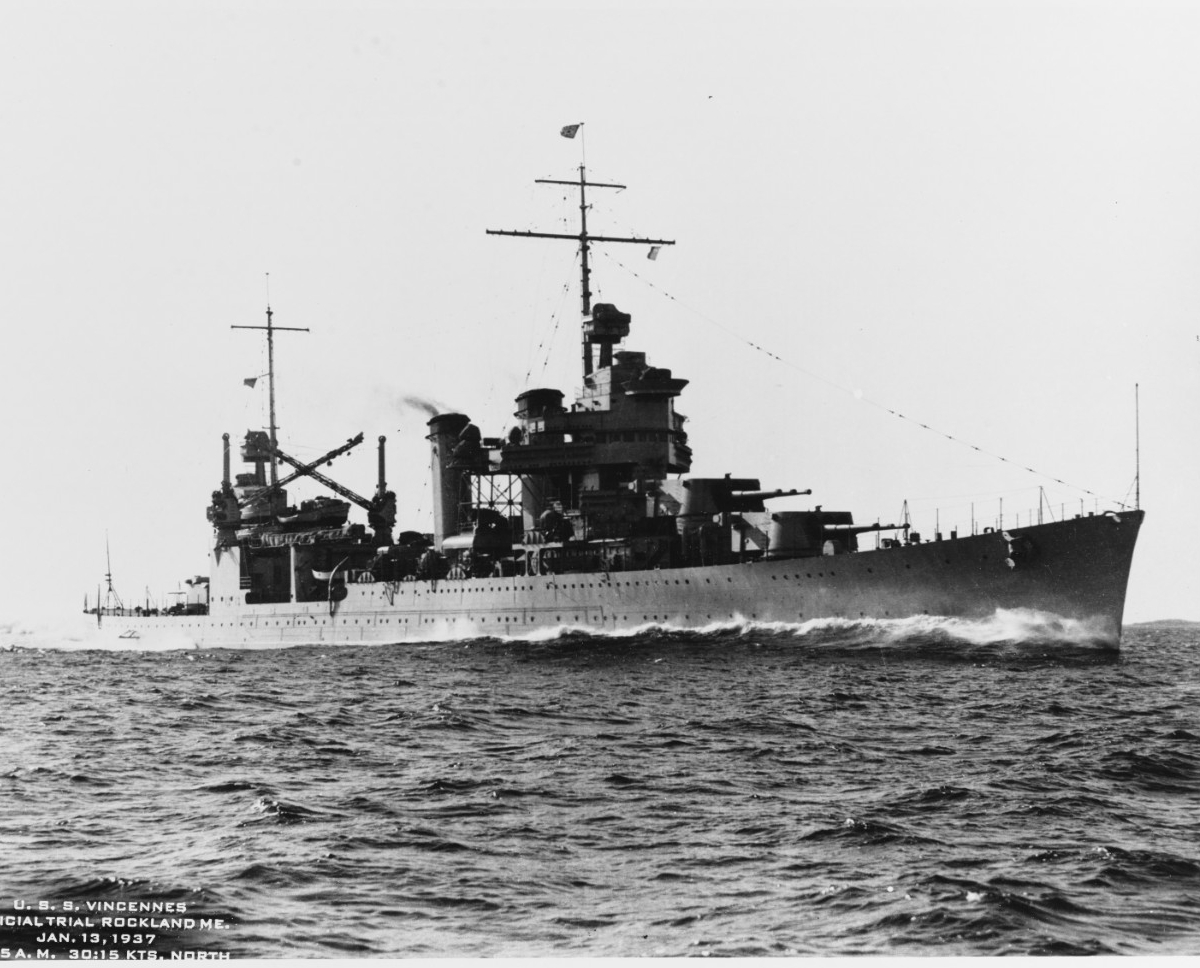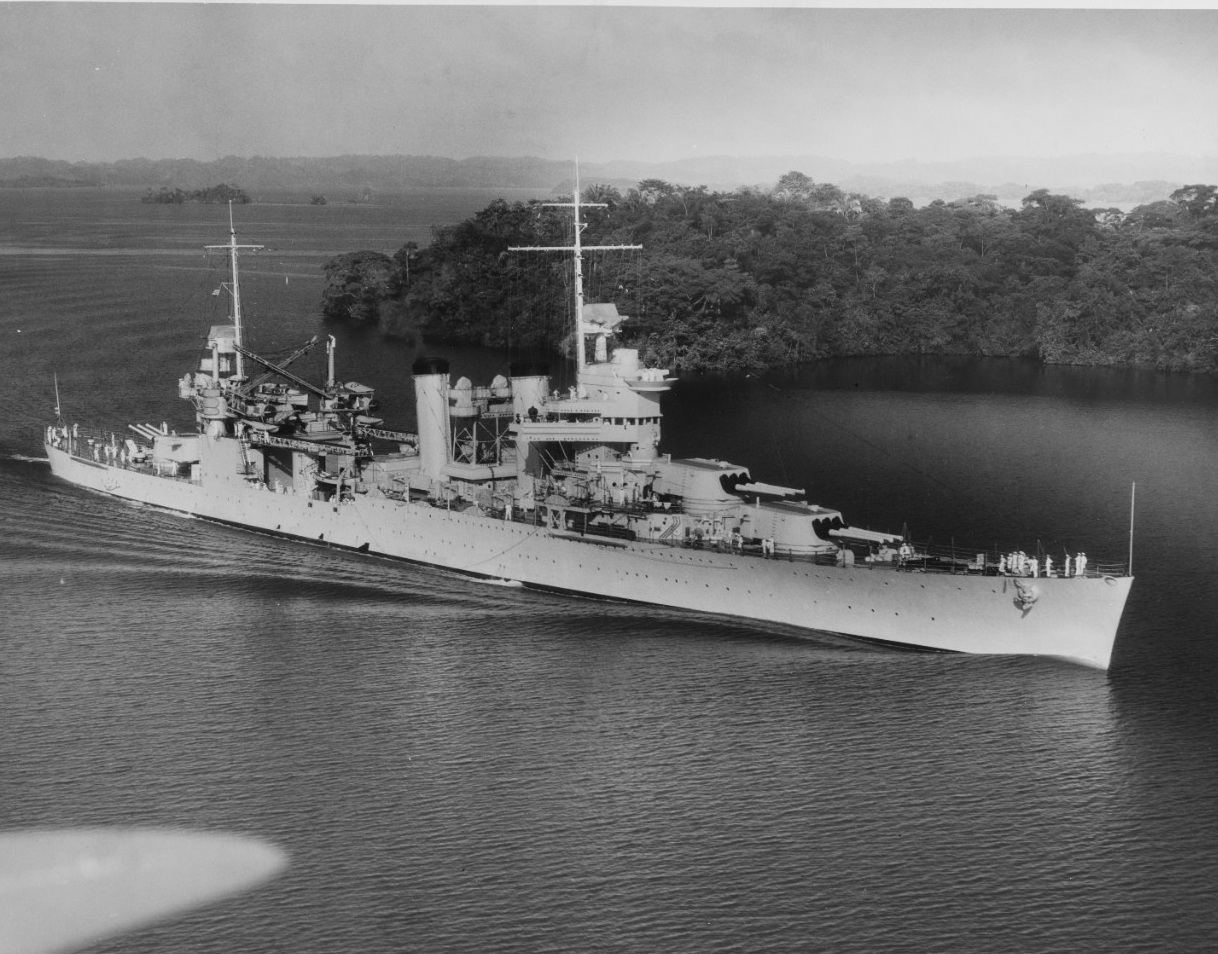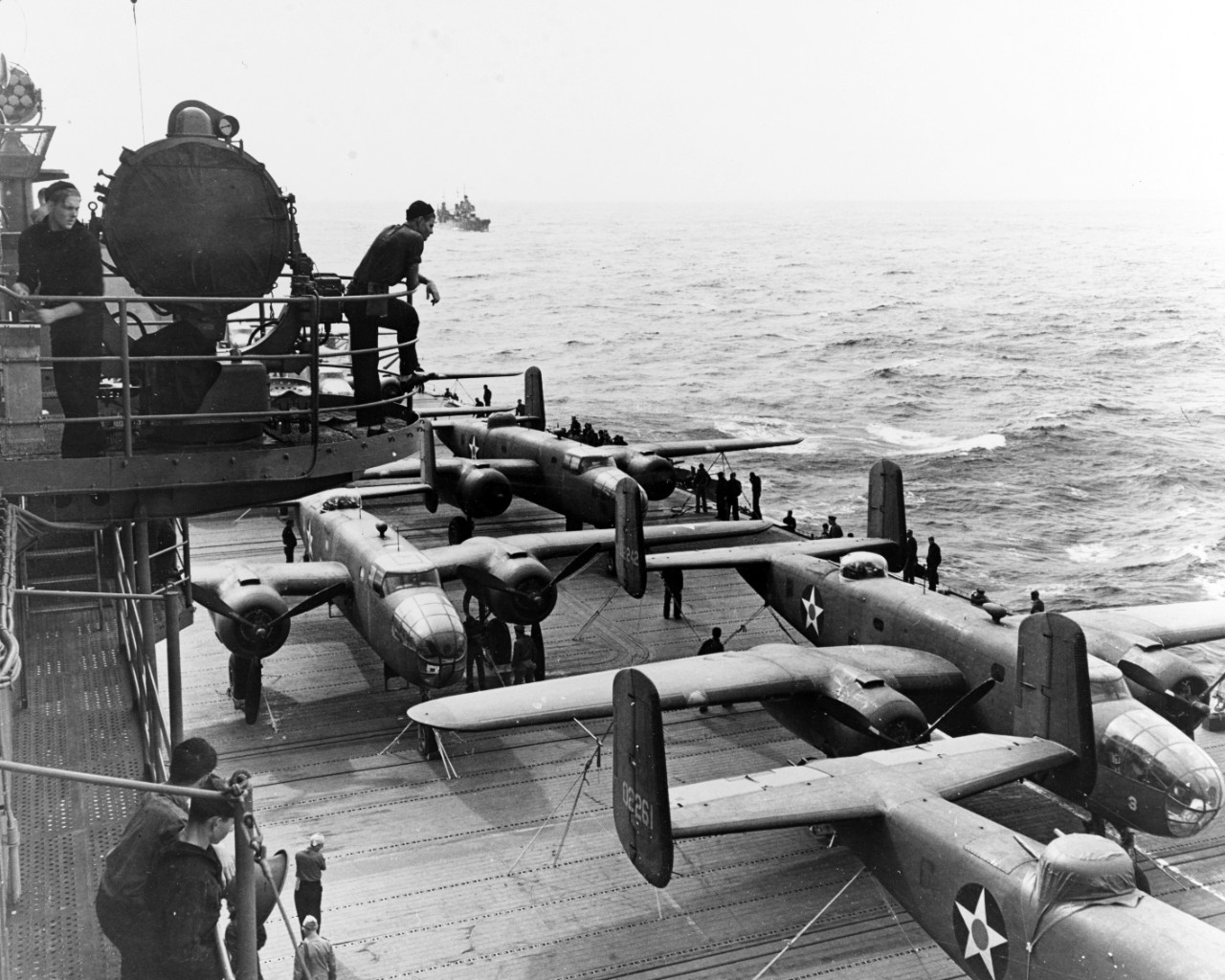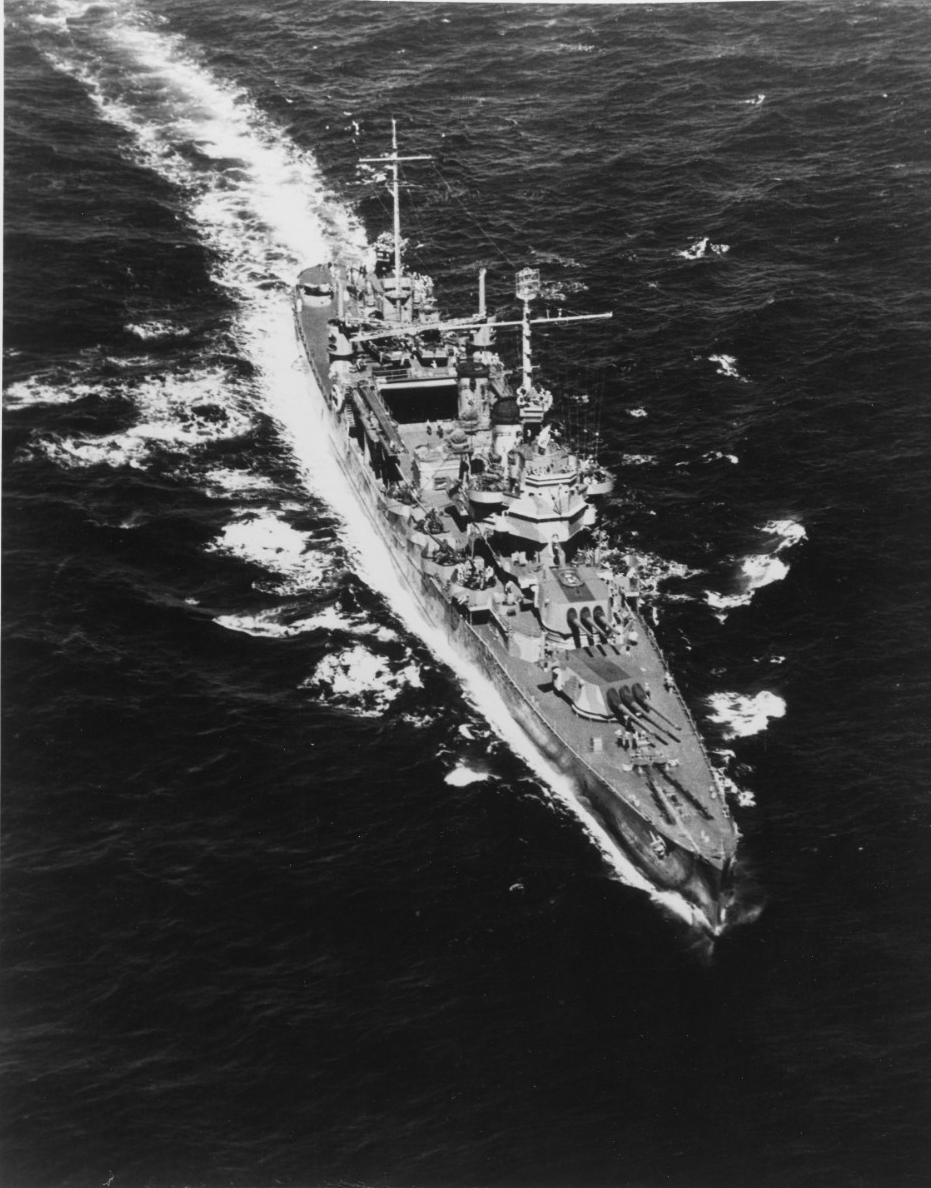Vincennes II (CA-44)
1937-1942
The second U.S. Navy ship named for the city in Knox County, Indiana.
II
(CA-44: displacement 9,400; length 588'0"; beam 61'10"; draft 18'8"; speed 32.7 knots; complement 952; armament 9 8-inch, 8 5-inch, 8 .50-caliber machine guns, 2 3-pounders (saluting); aircraft 4; class New Orleans)
Vincennes (CA-44) was laid down on 2 January 1934 at Quincy, Mass., by the Bethlehem Shipbuilding Company's Fore River plant; launched on 21 May 1936; sponsored by Miss Harriet Virginia Kimmell, daughter of the mayor of Vincennes, Ind.; and commissioned on 24 February 1937, Capt. Burton H. Green in command.
The new heavy cruiser departed from Boston on 19 April 1937 for her shakedown cruise which took her to Stockholm, Sweden; Helsingfors [Helsinki], Finland; Le Havre, France; and Portsmouth, England.
Early in January 1938, Vincennes was assigned to Cruiser Division (CruDiv) 7, Scouting Force, and steamed through the Panama Canal to San Diego. In March, the ship participated in Fleet Problem XIX in the Hawaiian area before returning to San Pedro for operations off the west coast for the remainder of the year.
Following an overhaul at the Mare Island Navy Yard, Vallejo, Calif., which lasted through April 1939, the cruiser returned east; transited the Panama Canal on 6 June in company with Quincy (CA-39), Tuscaloosa (CA-37), and San Francisco (CA-38); and anchored in Hampton Roads on the 13th. For the next two months, she operated out of Norfolk in the vicinity of the Chesapeake lightship and the southern drill grounds. On 1 September 1939, the day on which Hitler's legions marched into Poland and commenced hostilities in Europe,Vincennes lay at anchor off Tompkinsville, N.Y. She then began conducting Neutrality Patrols off the east coast, ranging into the Caribbean Sea and the Gulf of Yucatan, and continued these duties through the spring of 1940.
Late in May, as German troops were smashing Allied defenses in France, Vincennes steamed to the Azores and visited Ponta Delgada from 4 to 6 June 1940 before she proceeded on for French Morocco to load a shipment of gold for transport to the United States. While at anchor at Casablanca, the ship received word of Italy's declaration of war upon France, the "stab in the back" condemned by President Franklin D. Roosevelt soon thereafter. Capt. John R. Beardall,Vincennes' commanding officer, noted subsequently in his report of the cruise that "it was apparent that the French bitterly resented this [the declaration of war] and despised Italy for her actions." After departing North African waters on 10 June, the cruiser returned to the United States to offload her precious metallic cargo and return to the Neutrality Patrol.
Overhauling at Norfolk Navy Yard, Portsmouth, Va., into the first week of January 1941, Vincennes departed Hampton Roads on 7 January, in company with heavy cruiser Wichita (CA-45), and battleships New York (BB-34), and Texas (BB-35), bound for Guantanamo Bay, Cuba. Operating once again in the Caribbean, the heavy cruiser fired battle practice and gunnery exercises in company with Wichita through 18 January, when the two cruisers proceeded for Portland Bight, Jamaica, British West Indies. Conducting Neutrality Patrols from this port, Vincennes patrolled in company with other ships safeguarding neutral waters and America's recently acquired Caribbean bases.
Vincennes joined other Fleet units for landing exercises at Culebra, Puerto Rico, on 4 February 1941 and sent her 50-foot boats to assist in unloading and troop debarkation drills. She assisted the transports McCawley (AP-10) and Wharton (AP-7) in landing men and supplies before taking station with Fire Support Group II. The cruiser then fired simulated gunfire support operations with her main and secondary batteries.
For the remainder of February 1941, the ship continued her landing support operations with Transport Divisions 2 and 7, anchoring on occasion at Mayaguez or Guayanilla, Puerto Rico. Conducting operations out of Puerto Rican waters, Vincennes called at Pernambuco, Brazil, on 17 March and got underway for Capetown, South Africa, on the 20th. Arriving to a warm welcome nine days later, the ship took on a large shipment of gold bullion to pay for arms purchased in the U.S. by the United Kingdom and then headed home on the 30th. En route to New York, she conducted exercises. After a brief post-voyage period of repairs, the heavy cruiser sailed for the Virginia capes, where she rendezvoused with the aircraft carrier Ranger (CV-4) and destroyer Sampson (DD-394) ; proceeded on to Bermuda; and dropped anchor in Grassy Bay on 30 April. She patrolled in the Caribbean and off the Atlantic coast of the United States through June. On occasion, she steamed in company with such ships as Yorktown (CV-5), Augusta (CA-31), Ranger, Wichita, or Tuscaloosa.
After continuing her duties with the Neutrality Patrol into the autumn as American naval forces in the North Atlantic found themselves engaged in a de facto war with Germany, Vincennes undertook another mission to South African waters. She left the east coast late in November with Convoy WS-12, American transports carrying British troops. On 7 December 1941, the cruiser fought its way through heavy seas. Walls of water mercilessly pounded the ships of the convoy; and waves battered Vincennes, smashing a motor whaleboat to matchwood and ripping a Curtiss SOC Seagull floatplane from its "moorings" on the storm-lashed well deck amidships. The plane was battered against the catapult silos and into the hangar doors before it was swept over the ship's side. By that evening, however, the ship learned that she was not only at war with the elements but with Japan as well. Japanese naval air forces had struck Pearl Harbor and plunged the United States into war.
After having safely convoyed her charges to Capetown, where she arrived on 9 December 1941, Vincennes departed South African waters on the 16th, bound via Trinidad for Hampton Roads. Following her arrival at Norfolk on 4 January 1942, she shifted to New York four days later to be outfitted for war. Late in the month, she joined Hornet (CV-8) as the new carrier conducted her shakedown training off the east coast of the United States.
Vincennes sailed from New York on 4 March 1942, bound for the Pacific. She transited the Panama Canal on 11 March and proceeded via San Diego to San Francisco.
The heavy cruiser-now a part of Task Force (TF) 18, built around Hornet, departed San Francisco on 2 April. The carrier bore a strange deck cargo, 16 U.S. Army Air Force B-25 medium bombers slated to strike at Japan's heart. Vincennes rendezvoused with TF 16, built around Enterprise (CV-6) and, with the combined might of the two task forces, struck out westward across the Pacific, headed toward Japanese home waters.
Doolittle Raid on Japan, 18 April 1942. View looking aft and to port from the island of Hornet (CV-8), while en route to the mission's launching point. Vincennes (CA-44) is in the distance. Several of the mission's sixteen B-25B bombers are visible. That in the foreground is tail # 40-2261, which was mission plane # 7, piloted by 2nd Lieutenant Ted W. Lawson. The next plane is tail # 40-2242, mission plane # 8, piloted by Captain Edward J. York. Both aircraft attacked targets in the Tokyo area. Lt. Lawson later wrote the book Thirty Seconds over Tokyo. Note searchlight at left. U.S. Naval History and Heritage Command photograph. Catalog #: NH 53293.
On the morning of 18 April 1942, when the U.S. warships were still some 150 miles from the planned launch point, an unexpected hitch developed. Japanese giuard boats (armed trawlers) sighted and reported the task force. Vice Adm. William F. Halsey, Jr., decided to fly off the bombers immediately. Accordingly, all 16 of the heavily loaded B-25's,led by Lt. Col. James H. Doolittle, laden with bombs and extra fuel, rose from Hornet's spray-slicked flight deck and climbed unsteadily into the leaden gray skies. The daring raid proved the last straw to the frustrated Japanese military, which had been unable to counter U.S. carriers' unimpeded raids from the Marshalls and Gilberts to Lae and Salamaua. The U.S. carriers, Adm. Yamamoto Isoroku insisted, had to be destroyed; seizing Midway Atoll, he believed, would draw them out.
The combined Enterprise and Hornet task force retired eastward and made Pearl Harbor on 25 April 1942. Departing again five days later, the ships, still screened by Vincennes, bent on speed toward the Coral Sea. However, while unable to take part in the pivotal action which took place early in May in that body of water as planes from Yorktown and Lexington (CV-2) blunted the Japanese thrust toward strategic Port Moresby, they had been spotted heading towrd that region, causing alarm to the enemy, who experienced trouble keeping track of the elusive U.S. carriers.
Vincennes' task force returned to Pearl Harbor on 26 May 1942 but got underway again on the 29th, bound for waters off Midway Island, which, according to American intelligence, a Japanese invasion force was approaching. By 4 June, the heavy cruiser and her sister ship Astoria (CA-34), were steaming north of Midway.
At 1640, after carrier dive bombers from Yorktown and Enterprise had crippled three of the four Japanese carriers, a group of Nakajima B5N1 Type 97 carrier attack planes (later nicknamed Kate), from the Japanese carrier Hiryu approached from the north. Excellent damage control had permitted Yorktown to get underway after having been stopped by Japanese Aichi D3A1Type 99 carrier bombers (Val) from Hiryu.
TF 17's radar soon picked the Type 97s and their meager fighter escort up when 15 miles out, and Yorktown launched planes to intercept as her screen deployed to bring an optimum concentration of antiaircraft fire to bear upon the approaching enemy. Fighters from TF 16 headed for the fray as well. Three minutes after the first Nakajima was spotted, combat air patrol F4F Wildcats from Yorktown splashed one. The Type 97 spiraled from the sky trailing a streamer of smoke before crashing into the sea.
Vincennes opened fire at 1644 with her 5-inch, 20-millimeter, and 1.1-inch antiaircraft batteries on the Type 97s approaching from the port side. Increasing her speed to 25 knots and slowly turning to starboard, Vincennes kept her port guns trained on the enemy. While combing torpedo tracks, Vincennes bagged one B5N1 and sent it splashing into the sea 150 yards off her port bow.
The sharp, bitter action ended as quickly as it had begun. The Japanese had been driven off, but at a high cost for the Americans. Yorktown, mortally hit and listing to port, slowed to a halt. Vincennes altered course to follow Astoria's movements around the carrier, screening the stricken carrier from further air attacks. However, on 6 June, Japanese submarine I-168 slipped through a screen of six destroyers and torpedoed Yorktown and destroyer Hammann (DD-412), sinking the latter. The carrier rolled over and sank early on the 7th.
Returning to Pearl Harbor, Vincennes entered the navy yard for repairs and alterations which lasted until early July 1942. She then conducted tactical exercises off the island of Hawaii with other ships of TF 11 before departing Hawaiian waters on 14 July to rendezvous with TF's 16, 18, and 62.
Screening for transport squadron "X-ray," slated to participate in the Guadalcanal landings, Vincennes, in company with the light cruiser San Juan (CL-54) and Quincy, joined TF 62 on 26 July. On the 27th, the cruiser conducted approach exercises for landing practice and simulated bombardment drills off Koro Island in the Fiji group. As flagship for Task Group (TG) 62.3, Vincennes remained on station in the covering force in the transport area before undertaking further approach and landing exercise support drills.
Following refueling and revictualing, the heavy cruiser formed up with the American armada making its way to the Solomons. Vincennes, screening transport division "Yoke," arrived off Guadalcanal on 7 August 1942. At daybreak, beneath overcast skies, the ship catapulted her spotting planes and then unlimbered her main and secondary batteries to commence shore bombardment. While the thunder of the supporting ships' gunfire reverberated across the waters, marines disembarked from their landing craft and stormed ashore to meet initially light resistance on the island.
Shortly after 1320, Japanese planes launched a counterstrike. To sunward of the transports, Vincennes found herself in a favorable position to combat the attack and tracked the opposing planes, being among the first ships to open fire on the attackers. Forced to jettison their deadly loads prematurely, the Japanese retired without doing any damage; but not before Vincennes had bagged two of them. After sunset, Vincennes, Quincy, and Astoria, in company with destroyers Helm (DD-388) and Jarvis (DD-393), retired to conduct screening patrols.
Returning to her covering duties at daylight, Vincennes arrived at transport area "X-ray," off Guadalcanal by daybreak. Two minutes before noon, Japanese bombers, intent on avenging their losses of the day before and disrupting the landings, swooped down from Rabaul. Twenty-seven Mitsubishi G4M1 Type 1 attack bombers (later given the nickname Betty) swept in, in a low-level torpedo attack, and ran a gauntlet of gunfire from the transports and their escorting cruisers and destroyers. Three thousand yards from the transports, Vincennes, as in the previous day's action, was again in favorable firing position and opened up with every gun in her battery, from 8-inch to 20-millimeter, that could bear on the attackers.
During the ensuing melee, the cruiser used her main-battery 8-inch guns effectively, helping to down at least seven Mitsubishis which flew at an altitude of only 25 to 50 feet. The shell splashes from the main battery caused Japanese pilots to fly into walls of water or forced them to drastically alter their approaches. Vincennes dodged one torpedo which passed beneath her stern and evaded a bomb which fell off her port quarter. Jarvis, adjacent to the cruiser, took one torpedo hit.
Later, during the afternoon hours, aerial reconnaissance reported a Japanese surface force coming down from the base at Rabaul. These flights noted what was thought to be three cruisers, three destroyers, and two gunboats or seaplane tenders steaming south. While Jarvis limped away from Lunga Point, Vincennes and her sisters Quincy and Astoria steamed, as the northern escort force, to a position off Savo Island to screen the vulnerable transports which were still unloading off the invasion beaches. Capt. Frederick L. Riefkohl of Vincennes assumed that the enemy ships reportedly en route from Rabaul were going to launch and support another air attack early the following morning. He accordingly shaped night orders to be especially vigilant during the mid watch and fully expected an air attack at daybreak.
At about midnight on 8 August 1942, Riefkohl retired to his sea cabin, adjacent to the pilothouse, after having been on the bridge continuously since 0445 that morning. Turning in at 0050 on 9 August, he left his ship in the hands of Cmdr. William E. A. Mullan, the executive officer.
Nearly an hour later, at about 0145, lookouts spotted flares and star shells to the southward, accompanied by the low rumble of gunfire. The sound of the general quarters alarm soon rang throughout the ship and stirred her to action. Vincennes' lookouts were seeing the elimination of the southern escort group, formed around Chicago (CA-29) and the Australian heavy cruiser HMAS Canberra. Unbeknownst to the men manning the ships to the northward, a powerful enemy force was heading in their direction. Five heavy cruisers, one light cruiser, and one destroyer under the command of Japanese Vice Adm. Mikawa Gunichi had turned north and were steaming directly towards Vincennes and her two sisters.
The first Japanese searchlight beams illuminated Vincennes' splotchy Measure 12 (modified) camouflage shortly after 0155, and the embattled heavy cruiser opened fire with her main battery turrets to shoot out the troublesome light. Within a minute, however, Japanese shells bracketed the ship; and Vincennes shuddered under the impact of the hail of steel screaming in from the ebony sky. Bridge, carpenter shop, Battle II, and radio antenna trunks all were hit in the first salvo.
Altering course to port, Riefkohl, who had leapt to the bridge at the alarm, rang up for increased speed; but, in the deafening din of battle, and with his ship and her internal communications disrupted, it is doubtful that the order was received. Still moving at 19.5 knots, the heavy cruiser reeled under the impact of another group of direct hits.
Some of the shells in this group set afire the volatile planes in Vincennes' hangar space, and the resultant flames defied all attempts to extinguish them. A direct hit knocked the after antiaircraft director overboard. At 0200, Vincennes heeled to starboard in an attempt to evade the accurate enemy fire; but the probing Japanese gunners were not about to let the already sorely wounded ship escape. One or two torpedoes then ripped into the ship's number 1 fireroom and put it out of action.
Losing steering control five minutes later, Vincennes lay dead in the water within minutes. Rapidly hitting shells quickly reduced the ship's gun power to a fraction of its original strength and before long snuffed it out entirely. Like a pummelled and reeling challenger in the boxing ring, Vincennes wallowed to a halt. Hit at least 57 times by 8- and 5-inch shells, the ship gradually assumed a more alarming list.
As if mercifully, at 0210, the Japanese ceased fire and retired, leaving Savo Island and the burning hulks of the three American cruisers of the northern force in their wakes. As Vincennes' list increased to port, Riefkohl circulated the command to abandon ship at 0230. Serviceable life jackets and rafts were broken out, and the crew began the sad task of abandoning ship. At 0240, the captain went down to the main deck and joined the last men to leave the sinking cruiser and jumped into the tepid waters of Savo Sound.
Riefkohl subsequently wrote a fitting epitaph: "The Magnificent Vincennes, which we were all so proud of, and which I had the honor to command since 23 April 1941, rolled over and then sank at about 0250, 9 August about 2- miles east of Savo Island . . . Solomons Group, in some 500 fathoms of water."
Stricken from the Navy List on 2 November 1942, Vincennes was awarded two battle stars for her World War II service, recognizing her participation in the Battle of Midway (3-6 june 1942) and the Guadalcanal-Tulagi landings (including First Savo) (7-9 August 1942).
Robert J. Cressman
8 March 2022






